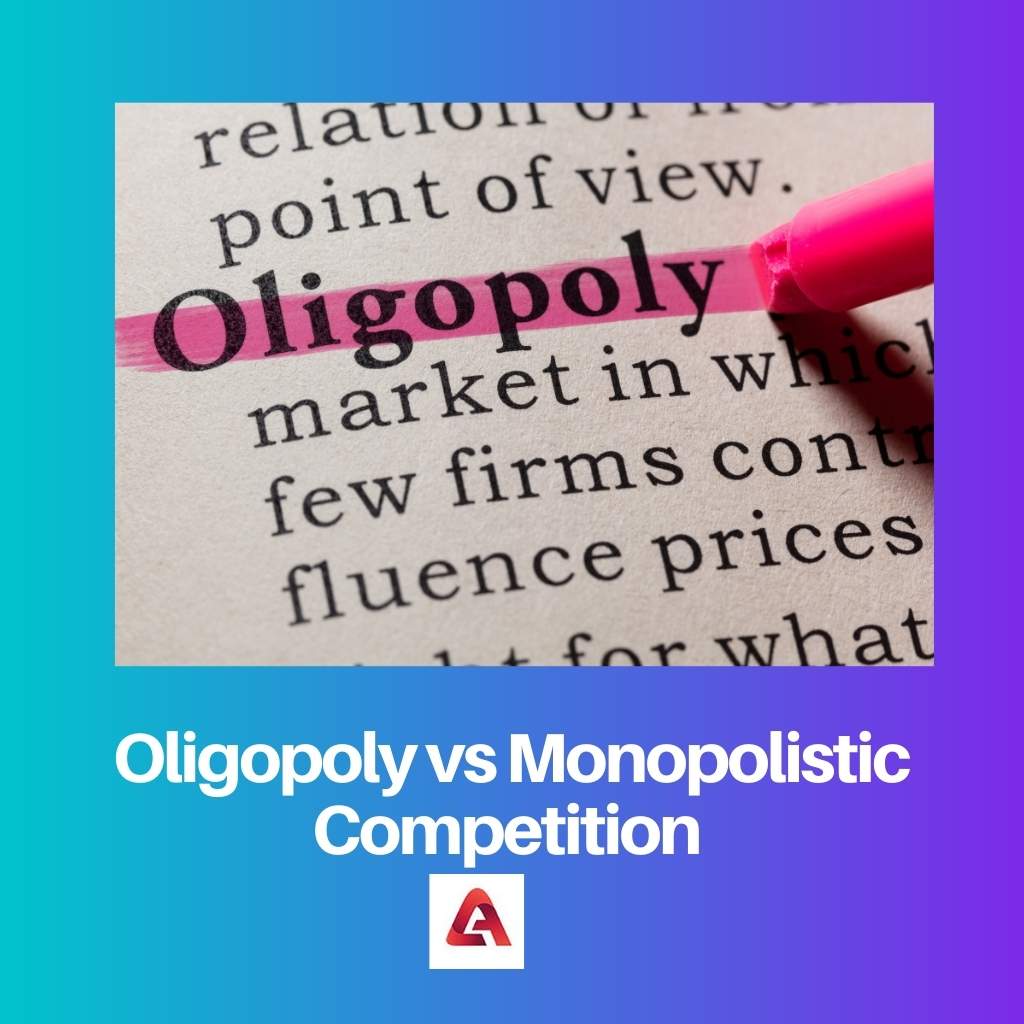Market structure in economics determines the demand and supply of the products in the market. We buy certain types of products from certain markets, for instance, Buying an iOS phone from an iPhone shop.
In the market structure, firms sell their product either homogeneous or differentiated to the customers under perfect competition, monopolistic competition, monopoly, or Oligopoly. Different characteristics are played under different types of market structure as it depends on the nature of the product, entry and exit, the number of sellers or buyers, and price determination.
Key Takeaways
- In an oligopoly, many large firms dominate the market and control prices significantly. In contrast, in monopolistic competition, many small firms operate in the market and cannot influence prices.
- Oligopoly results in firms cooperating to restrict competition and increase profits, while the monopolistic competition promotes product differentiation to gain a competitive edge.
- While high barriers to entry characterize oligopoly due to the dominance of large firms, the monopolistic competition allows for relatively easy entry and exit of small firms.
Oligopoly vs Monopolistic Competition
Oligopoly refers to a market structure where a few large firms dominate the market and have the ability to set prices. Monopolistic competition is a market structure where many firms sell similar but not identical products, and they compete on price, quality, and marketing.

Oligopoly comes under perfect competition, where products are sold either homogeneously or differentiated. An oligopoly market imposes proscriptions on the entry and exit of firms as their actions are interlinked from one firm to another one.
Oligopoly covers small sellers of large firms. For instance, automobile companies sell cars either in a similar model or in an upgraded model.
Monopolistic competition is an imperfect competition market with many firms selling differentiated products with a close substitute. Those firms are independent in determining certain products’ price, demand, and supply.
Entry and exit of firms under monopolistic competition are done freely without any government involvement. Furthermore, Monopolistic competition is subsumed by many firms, where each MC firm sells a similar product.
On the other hand, other MC firms sell their selected similar product.
Comparison Table
| Parameters of Comparison | Oligopoly | Monopolistic Competition |
|---|---|---|
| Meaning | An oligopoly market is a small number of sellers of large firms tout interlinked homogeneous or differentiated products to the customers. | Monopolistic competition is imperfect competition, with many firms selling particular or grouped heterogeneous products to the customers. |
| Number of sellers | There are a few sellers of large firms. | There are many MC firms, where each firm sells a set of similar products while competing with other MC firms who are selling another set of different products. |
| Entry and Exit | Strict barriers to entry and exit of oligopoly firms to the market can reflect the other firm’s actions as actions of one firm. Moreover, Government regulation on the entry of new firms is quite difficult as the existing firm is already making an optimized profit. | The entry and exit of Monopolistic competition are free, where the new firm can enter as well as existing firms sustaining loss can freely leave the market. |
| Nature of products | Oligopoly firms sell homogeneous products which are similar in size, shape, colour, material and price. Sometimes, they also sell differentiated products to compete with other firms. | The nature of products under monopolistic competition is heterogeneous or differentiated products. The firms sell products that are different in size, colour, shape or price. |
| Interdependence | Oligopoly firms are highly interdependent on other firm’s actions because there are only a few firms in the market selling analogous products. Therefore, the action of one firm makes an impact on other firms. So setting prices may reflect the performance of other firms in an oligopoly market. | Monopolistic competition firms are independent. A monopoly is termed as a single firm selling or setting products at their own decided price. |
| Examples | The automobile industry of large firms- like Tata Motors sells homogeneous products. | Monopolistic competition examples are restaurants like Dominos sells Aloo Tikka Pizza in India, whereas pepperoni pizza sells in American firms. |
What is Oligopoly?
An Oligopoly market is one of the market structures under perfect competition, where a few numbers of sellers gather together with large firms and sell similar or homogeneous products to the customer. Oligopoly has stringent barriers to the entry of new firms or the departure of any existing firms.
Those barriers are government licenses, access to expensive techniques or economics etc. Moreover, government regulation will not allow new firms into oligopolies because of high competition.
This way, oligopoly markets are long-run abnormal profits because of the restriction on competitors.
The seller is the price setter under an oligopoly market, as they are interdependent from one firm to another. Buyers have imperfect knowledge about the price and product quality because their inter-firm information is bungling.
Besides, Oligopoly drives customers through selling costs that are advertisement, campaign, or loyalty schemes.
To sum up, an Oligopoly is a market structure where a small group of large firms (interdependent) sells analogous or differentiated products to customers.

What is Monopolistic Competition?
Monopolistic competition is an imperfect market structure where many firms compete with each other by selling differentiated products with close substitutes. The entry and exit of firms under monopolistic competition are free, so this leads to a high degree of competition, whereas those firms sustaining loss can freely depart the market.
Monopolistic competition is independent firms, where they are the price setter as they sell certain products within the MC group to compete with other MC groups who are selling differentiated products.
Monopolistic competition faces inefficiency in the market as the price exceeds the marginal cost of a product as they spend more on selling costs to get publicity in the market. Restaurants are great examples of monopolistic competition as they vend food by altering something like the way of serving or packaging, but the food taste of one MC group may differ from another MC firm.
Exterlopulate the concept of monopolistic competition. Many firms are involved in selling only differentiated products in order to compete with each other.

Main Differences Between Oligopoly and Monopolistic Competition
- Oligopoly is an interdependent market where few sellers of large firms tout homogeneous or differentiated products to the customers. On the other hand, Monopolistic competition is an imperfect market where many firms engage in selling differentiated with close substitute products.
- The oligopoly market has few small sellers of large firms, whereas many firms carry Monopolistic competition.
- Barriers are made to entry and exit in the oligopoly market as the sellers are interdependent. Albeit, Monopolistic competition firms can enter and exit freely.
- Oligopoly sells homogeneous products such as similar in size, price and colour. But, a Monopolistic competition firm sells heterogeneous products which are so different in size, shape, colour, and materials.
- Under an oligopoly market, the actions of one’s firm reflect the other’s firm’s actions as they interlink. Monopolistic competition is an independent market where the firm can determine the demand and supply.
- https://www.sciencedirect.com/science/article/pii/S1573448X89010095
- https://link.springer.com/chapter/10.1007/978-1-349-19802-3_23

The article presents a comprehensive overview of oligopoly and monopolistic competition, shedding light on their distinct characteristics and impact on market operations.
The examples provided for both oligopoly and monopolistic competition highlight real-world scenarios, making it easier to understand the application of these concepts in different industries.
The article provides insightful information on how oligopoly and monopolistic competition impact market dynamics. The comparison between the two is well articulated.
The comparison of entry and exit barriers, as well as the nature of products, helps in understanding how oligopoly and monopolistic competition affect competition and market dynamics.
The comparison table provided is very helpful in summarizing the key differences between oligopoly and monopolistic competition. It provides a clear overview for readers.
The article effectively delineates the differences between oligopoly and monopolistic competition, specifically in terms of entry and exit barriers and interdependence or independence of firms.
The article provides a clear and detailed explanation of the different market structures in economics, and how oligopoly and monopolistic competition differ from each other.
The article’s explanation of the nature of products and entry and exit in both oligopoly and monopolistic competition is detailed and comprehensive, offering insights into their distinct features.
The article provides a comprehensive understanding of oligopoly and monopolistic competition, and their respective impacts on price determination and market control.
Understanding the difference between oligopoly and monopolistic competition is crucial for analyzing market dynamics and consumer behavior. The article explains this distinction effectively.